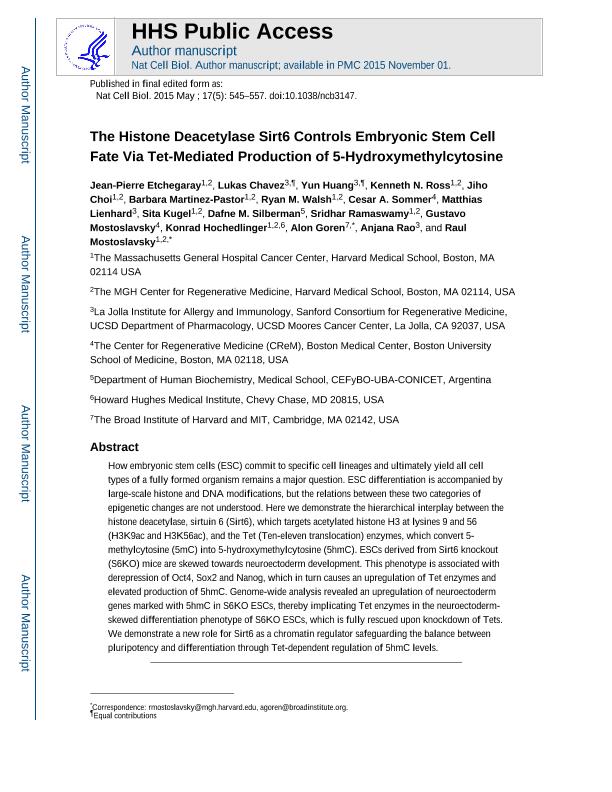Mostrar el registro sencillo del ítem
dc.contributor.author
Etchegaray, Jean Pierre
dc.contributor.author
Chavez, Lukas
dc.contributor.author
Huang, Yun
dc.contributor.author
Ross, Kenneth N.
dc.contributor.author
Choi, Jiho
dc.contributor.author
Martinez Pastor, Barbara
dc.contributor.author
Walsh, Ryan M.
dc.contributor.author
Sommer, Cesar A.
dc.contributor.author
Lienhard, Matthias
dc.contributor.author
Gladden, Adrianne
dc.contributor.author
Kugel, Sita
dc.contributor.author
Silberman, Dafne Magalí

dc.contributor.author
Ramaswamy, Sridhar
dc.contributor.author
Mostoslavsky, Gustavo

dc.contributor.author
Hochedlinger, Konrad
dc.contributor.author
Goren, Alon

dc.contributor.author
Rao, Anjana
dc.contributor.author
Mostoslavsky, Raul

dc.date.available
2018-05-14T20:39:28Z
dc.date.issued
2015-05
dc.identifier.citation
Etchegaray, Jean Pierre; Chavez, Lukas; Huang, Yun; Ross, Kenneth N.; Choi, Jiho; et al.; The histone deacetylase SIRT6 controls embryonic stem cell fate via TET-mediated production of 5-hydroxymethylcytosine; Nature Publishing Group; Nature Cell Biology; 17; 5; 5-2015; 545-557
dc.identifier.issn
1465-7392
dc.identifier.uri
http://hdl.handle.net/11336/45155
dc.description.abstract
How embryonic stem cells (ESCs) commit to specific cell lineages and yield all cell types of a fully formed organism remains a major question. ESC differentiation is accompanied by large-scale histone and DNA modifications, but the relations between these epigenetic categories are not understood. Here we demonstrate the interplay between the histone deacetylase sirtuin 6 (SIRT6) and the ten-eleven translocation enzymes (TETs). SIRT6 targets acetylated histone H3 at Lys 9 and 56 (H3K9ac and H3K56ac), while TETs convert 5-methylcytosine into 5-hydroxymethylcytosine (5hmC). ESCs derived from Sirt6 knockout (S6KO) mice are skewed towards neuroectoderm development. This phenotype involves derepression of OCT4, SOX2 and NANOG, which causes an upregulation of TET-dependent production of 5hmC. Genome-wide analysis revealed neural genes marked with 5hmC in S6KO ESCs, thereby implicating TET enzymes in the neuroectoderm-skewed differentiation phenotype. We demonstrate that SIRT6 functions as a chromatin regulator safeguarding the balance between pluripotency and differentiation through Tet-mediated production of 5hmC.
dc.format
application/pdf
dc.language.iso
eng
dc.publisher
Nature Publishing Group

dc.rights
info:eu-repo/semantics/openAccess
dc.rights.uri
https://creativecommons.org/licenses/by/2.5/ar/
dc.subject
Sitr6
dc.subject
Stem Cells
dc.subject
Development
dc.subject.classification
Otras Ciencias Biológicas

dc.subject.classification
Ciencias Biológicas

dc.subject.classification
CIENCIAS NATURALES Y EXACTAS

dc.title
The histone deacetylase SIRT6 controls embryonic stem cell fate via TET-mediated production of 5-hydroxymethylcytosine
dc.type
info:eu-repo/semantics/article
dc.type
info:ar-repo/semantics/artículo
dc.type
info:eu-repo/semantics/publishedVersion
dc.date.updated
2018-03-13T18:15:49Z
dc.journal.volume
17
dc.journal.number
5
dc.journal.pagination
545-557
dc.journal.pais
Reino Unido

dc.journal.ciudad
Londres
dc.description.fil
Fil: Etchegaray, Jean Pierre. Harvard Medical School; Estados Unidos
dc.description.fil
Fil: Chavez, Lukas. La Jolla Institute for Allergy and Immunology; Estados Unidos. Texas A&M University; Estados Unidos
dc.description.fil
Fil: Huang, Yun. La Jolla Institute for Allergy and Immunology; Estados Unidos. Texas A&M University; Estados Unidos
dc.description.fil
Fil: Ross, Kenneth N.. Harvard Medical School; Estados Unidos
dc.description.fil
Fil: Choi, Jiho. Harvard Medical School; Estados Unidos
dc.description.fil
Fil: Martinez Pastor, Barbara. Harvard Medical School; Estados Unidos
dc.description.fil
Fil: Walsh, Ryan M.. Harvard Medical School; Estados Unidos
dc.description.fil
Fil: Sommer, Cesar A.. Boston University; Estados Unidos
dc.description.fil
Fil: Lienhard, Matthias. La Jolla Institute for Allergy and Immunology; Estados Unidos
dc.description.fil
Fil: Gladden, Adrianne. Massachusetts Institute of Technology; Estados Unidos
dc.description.fil
Fil: Kugel, Sita. Harvard Medical School; Estados Unidos
dc.description.fil
Fil: Silberman, Dafne Magalí. Consejo Nacional de Investigaciones Científicas y Técnicas. Oficina de Coordinación Administrativa Houssay. Centro de Estudios Farmacológicos y Botánicos. Universidad de Buenos Aires. Facultad de Medicina. Centro de Estudios Farmacológicos y Botánicos; Argentina. Universidad de Buenos Aires. Facultad de Medicina. Departamento de Bioquímica Humana; Argentina
dc.description.fil
Fil: Ramaswamy, Sridhar. Harvard Medical School; Estados Unidos. Boston University; Estados Unidos
dc.description.fil
Fil: Mostoslavsky, Gustavo. Boston University; Estados Unidos
dc.description.fil
Fil: Hochedlinger, Konrad. Harvard Medical School; Estados Unidos. Howard Hughes Medical Institute; Estados Unidos
dc.description.fil
Fil: Goren, Alon. Massachusetts Institute of Technology; Estados Unidos
dc.description.fil
Fil: Rao, Anjana. La Jolla Institute for Allergy and Immunology; Estados Unidos. University of California at San Diego; Estados Unidos
dc.description.fil
Fil: Mostoslavsky, Raul. Harvard Medical School; Estados Unidos
dc.journal.title
Nature Cell Biology

dc.relation.alternativeid
info:eu-repo/semantics/altIdentifier/doi/http://dx.doi.org/10.1038/ncb3147
dc.relation.alternativeid
info:eu-repo/semantics/altIdentifier/url/https://www.nature.com/articles/ncb3147
dc.relation.alternativeid
info:eu-repo/semantics/altIdentifier/url/https://www.ncbi.nlm.nih.gov/pmc/articles/PMC4593707/
Archivos asociados
